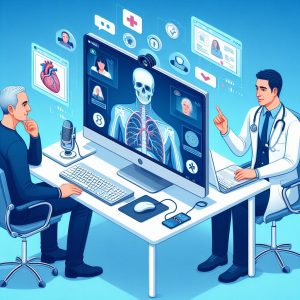Introduction
Telehealth video conferencing enables patients to access healthcare services remotely through video and audio connectivity. Patients connect with doctors or specialists via video call rather than visiting facilities in-person.
Video consultations are growing rapidly in healthcare, driven by technology improvements and the COVID-19 pandemic’s social distancing needs. Telehealth video confers multiple benefits, including improved access, more time-efficient care, and lower costs. However, providers must ensure high-quality user experiences and manage technical challenges.

Benefits of Telehealth Video Conferencing
Implementing telehealth video consultations offers significant advantages:
Time-Efficiency and Streamlined Delivery
- Virtual visits save patients travel time compared to in-clinic appointments. Appointments can start promptly as patients join from home.
- Doctors save time moving between patients by connecting with them continuously through video. Some administrative tasks also transition online.
- Video streamlines consultations, referrals, and specialist coordination without patients relocating to multiple sites.
Remote Access to Healthcare
- Video consultations enable patients in remote or underserved areas to conveniently access quality healthcare. Geographic barriers no longer limit care.
- Homebound patients including the elderly, chronically ill, or disabled can receive regular care without leaving their residence.
- Patients who have moved away can continue care with existing providers using video rather than finding new local doctors.
Improved Patient Care and Monitoring
- Regular video check-ins allow earlier interventions as doctors observe patients’ conditions in real-time through video. Small changes in health or behavior can be caught sooner.
- Remote patient monitoring programs use devices to capture health metrics that doctors review in video consultations. This enables closer monitoring.
- Post-discharge follow-ups via video provide smoother transitions and help prevent complications or readmissions.
Cost Savings
- Eliminating facility visits and travel time reduces costs for both patients and providers. Video consults also enable shorter yet more frequent interactions.
- Shifting care to outpatient video settings avoids higher costs of emergency or inpatient services. Ongoing monitoring helps prevent acute episodes requiring hospitalization.
- Providers optimize staffing and resources by consolidating in-person and video patients onto shared schedules.
Key Aspects to Consider in Video Consultations
Deploying telehealth video confers several technical, operational, and regulatory considerations:
Technical Requirements and Troubleshooting
- Sufficient internet bandwidth, computer processing, and audiovisual capabilities are required for both patients and providers.
- Testing connectivity, equipment, and video settings ahead of visits minimizes technical delays. Troubleshooting support should be available.
- Platforms should be highly reliable and secure to prevent privacy or safety risks from interruptions.
Integration with Existing Platforms and Systems
- Telehealth platforms should integrate smoothly with hospital IT systems, EMRs, scheduling, and billing. Data from video visits should be capturable in health records.
- Workflows should facilitate clinicians conducting a mix of in-person and virtual consultations across their patient panel.
- Platforms should be device agnostic and accessible across desktops, mobile devices, and telehealth stations to maximize access.
Regulatory Compliance and Pricing
- Confirm video consultations comply with regulations like HIPAA as well as malpractice insurance requirements. Follow informed consent, privacy, and prescribing policies.
- Reimbursement rates, coverage requirements, and service codes vary across private and government insurance programs. Verify telehealth policies.
- Organizations must decide appropriate pricing models considering costs, competitors, service mix, subsidies, and target populations.
Quality of Service and User Experience
- Sufficient training, user support, and simple interfaces are required for clinicians and patients to use telehealth seamlessly.
- Surveys, ratings, and usage metrics should be tracked to identify opportunities to optimize video workflows and increase user satisfaction.
Challenges and Solutions in Telehealth Video Conferencing
Despite its advantages, telehealth video conferencing also poses some implementation challenges:
Disparities in Patient Hardware, Internet, and Tech Ability
- Socioeconomic barriers can limit hardware ownership and broadband access for disadvantaged populations. Programs can provide video kits and internet hotspots.
- Training and user guides should accommodate diverse technical skill levels. Tech support assists patients needing extra help.
- Hardware and internet requirements should be modest to maximize accessibility. Data plans can ease mobile costs.
Troubleshooting Hardware and Software Issues
- Having an IT help desk optimizes technical support for patients and clinicians managing device or platform problems.
- Proactive system monitoring and maintenance helps identify problems before they disrupt visits. Analytics identify recurring technical bottlenecks.
- Resources should outline hardware specifications and ideal telehealth spaces to minimize connectivity or setup issues.
Ensuring Compliance and Managing Reimbursement
- Detailed documentation around telehealth workflows, data security, consent, prescribing, andmore ensures continued compliance as regulations evolve.
- Insurance verification and submission processes must be clearly defined to secure proper reimbursement and avoid penalties for non-compliance.
Examples of Successful Implementations
- Home Telehealth for Chronic Conditions – Programs like the VA Home Telehealth Program reduced complications through ongoing video monitoring of chronic disease patients at home. Patients took vital signs, answered symptom questions, and reviewed results with nurses during video check-ins several times per week. The program cut hospitalizations by over 50%.
- Mental Health Services – Providers like Doctor on Demand and Amwell deliver mental health counseling and psychiatry visits via video. Appointments bridge gaps between in-person therapy while making care more accessible. Video also enables subtle observation of factors like mood, affect, hygiene, and environment.
- Rural Telehealth Services – In rural regions, community hospitals leverage telehealth to bring medical, behavioral health, and specialty services on-screen rather than requiring patients to travel great distances. Partnerships with urban health systems facilitate consults with distant specialists. This also keeps care dollars within local communities.
Conclusion
Telehealth video conferencing expands access and convenience in healthcare services while providing cost benefits. However, smooth technical execution and user-friendly experiences are essential for sustaining utilization.
Looking ahead, advancing connectivity, wearables, decentralization, AI diagnosis, and VR/AR environments will shape video’s ongoing evolution in healthcare. Telehealth is projected to play an ever-increasing role in bridging gaps, enhancing monitoring, enabling expert collaboration, and ultimately improving patient outcomes. Providers who leverage the capabilities of emerging video technologies while prioritizing user-centric design are poised to deliver the healthcare of the future, today.

